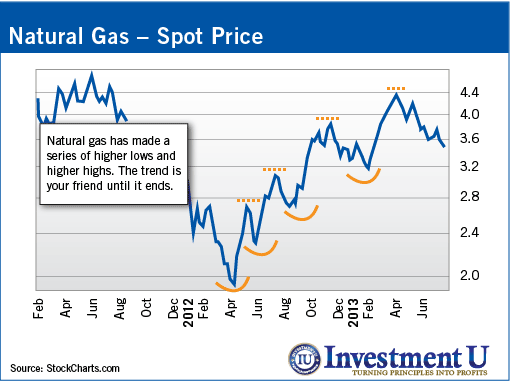Are you looking for a rip-roaring bull market? Take a long, hard look at natural gas.
Its price increased 40% to 60% during the first half of 2013 compared to the same period in 2012. If the S&P 500 did that, fat-cat bankers would do cartwheels down Wall Street.
The price of natural gas is still off its highs of a few years ago. But it rebounded off last year’s bottom and the pace of gains in U.S. production is slowing – growing just 1.8% in the first half of 2013 compared to 5.6% growth in 2012 and 7.3% in 2011, according to the Energy Information Administration.
There’s a reason for that. Producers have shut down more than half their drilling rigs since late 2011. Anybody can see where the trend in both drilling and production is going, and it’s bullish for prices longer term.
The price of natural gas in the U.S. is about one-fourth the average global price. Heck, people in Japan pay six times what we do for natural gas. This gives U.S. manufacturers that use natural gas as an input (fertilizer manufacturers, chemical makers, any manufacturer with high energy inputs) a competitive edge globally.
Natural gas is still cheap despite its rally. But will it stay that way? Let’s look at a chart:

Natural gas was one of the worst-performing commodities last week, falling nearly 8% on forecasts for cooler summer weather, which will result in less cooling demand. But I don’t think that’s a sign to sell. Instead, it’s a buying opportunity.
The rally in natural gas has just begun. I think that by the end of 2015 natural gas will hit $6.50. That’s one heck of a move.
What would fuel that move? For one thing, demand is expected to rise. Houston-based investment bank Simmons & Company estimates that demand for U.S. natural gas will climb from about 70 billion cubic feet (bcf) per day, to as much as 90 bcf per day by 2020.
Simmons says that higher demand will start pushing up prices within 18 months.
Some of that demand will come from U.S. manufacturing, which continues to rebound. Durable goods orders are increasing and flash manufacturing purchasing managers’ index beat expectations and hit a four-month high of 53.2 in July. Bullish? I’d say so, yeah.
But the big demand for U.S. natural gas will come from exports. For example, Mexican demand for U.S. gas exports has surged 92% over the past five years. Mexico’s total imports hit 767 billion cubic feet in 2012. Plenty of new pipeline projects are snaking their way across Arizona and Texas, with an eye on exporting more natural gas to Mexico.
And there are a lot more exports to come. Liquefied natural gas (LNG) exports will start in 2015 and there are 20 export licenses for LNG pending (two are already approved). I expect prices to rise in anticipation of further exports.
There are also new sources of demand that most Americans don’t even know about yet. For example, China gets just 5% of its total energy from natural gas. The U.S. is the world’s top gas producer and gets 26% of its total energy from gas.
Yet China already has 1.5 million vehicles operating on natural gas, while the U.S. has just 250,000.
Does that math make any sense to you? Heck, no! And I think that math is going to change in a big way.
More opportunities around the corner
And here’s the funny thing. Even if U.S. natural gas prices doubled, it would still be cheap compared to what they’re paying in Europe and Asia. So, many of the same economies that are driving the natural gas production and natural gas-fueled manufacturing booms would remain in place.
I like that math, too. That’s the kind of math that can put a lot of profits in your pockets.
https://www.investmentu.com/